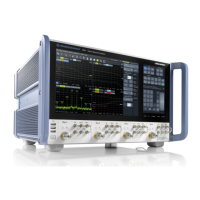GUI reference
R&S
®
ZNA
766User Manual 1178.6462.02 ─ 20
●
When the "Fault Limit" is modified, the new "Fault Limit" replaces other limit lines
(see Chapter 5.6.1.2, "Define Limit Lines dialog", on page 435)
●
This field is only enabled, if Fault Limit Check is active.
Remote command:
CALCulate<Chn>:TRANsform:DTFault:PEAK:THReshold
Fault List...
This button is only enabled, if Fault Limit Check is active.
It opens the Fault List dock widget.
5.17.3.2 Available Cable Types... dialog
The "Available Cable Types..." dialog allows you to display predefined and user-
defined cable types and to add/modify/delete user-defined cable types.
Among the predefined cable types, there is an ideal air line (with a relative permittivity
of 1, a corresponding velocity factor of 1, and zero attenuation) and a wide range of
standard cable types.
Cable types are defined by their relative permittivity εr or, equivalently, by their velocity
factor 1/sqrt(εr), and a frequency-dependent attenuation table (see "Frequency-
Dependent Attenuation Table" on page 766)
The velocity factor is a measure for the velocity of an electromagnetic wave in a dielec-
tric with permittivity ε
r
, relative to its velocity in a vacuum (velocity factor < 1). It is nee-
ded to convert the propagation times into distances.
Frequency-Dependent Attenuation Table
The "Attenuation of <Cable Type>" dialog defines the frequency dependence of the
cable attenuation. The measured cables are assumed to be homogeneous so that the
attenuation per length unit is constant. This means that the attenuation can be
expressed in units of dB/m. Due to the skin effect and various other factors, the attenu-
ation is frequency-dependent.
Applic softtool

